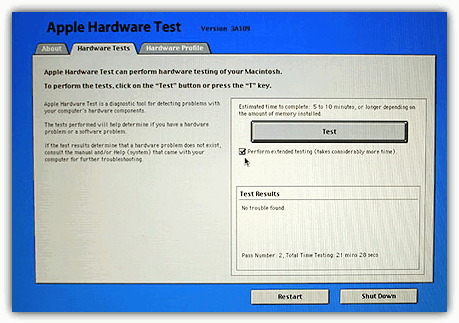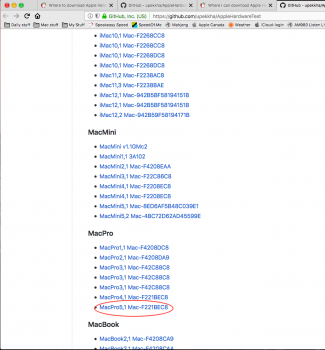January 2001 – Apple Hardware Test for Power Mac G4 Cube version 1.1 – Download G4 Cube, will not work with any other computer. January 2002 – Apple Service Diagnostic 062602 1.0 XServe – Download. The Apple Hardware Test (AHT) can troubleshoot your Mac's hardware issues. Using AHT over the internet runs the test without needing local media. One of the easiest ways to know whether a Mac is a hardware problem is to run 'function test Apple hardware Diagnostics or Apple. Yes, most users of Apple.
How to launch and use Apple's built-in hardware diagnostic tools, such as Apple Hardware Test and Apple Diagnostics?
Apple computers are well known for their stability and performance, and also use of hardware resources. Many people state that Mac computers never crash, however, there is always a chance of hardware or software crashes on any system. To help users in this respect, Apple included a built-in diagnostic tool that checks all computer components and displays results and recommendations about how to solve any existing issues. The tool (called Apple Hardware Test) provided multiple diagnostic tests on all Mac computers, and was available until 2013. Later, Apple slightly changed the name (Apple Diagnostics) and appearance on all models released after 2013.
Releasing the newer version of the diagnostic tool, developers attached error codes to the report about existing errors. This helps to find possible solutions. Launching this tool, you can check hard disk drive failures, memory faults, and video graphic card (GPU) and processor (CPU) performance. You can also check the entire motherboard and additional modules, such as network and Bluetooth adapters. Even fan operation can be scanned for possible errors. The diagnostic tool can help if your are experiencing issues that software solutions could not fix. This is achieved by scanning the entire computer, both hardware and software. Knowing the source of the problem enables you to apply a solution. In this article, we describe how to launch the Apple Hardware Test and Apple Diagnostics programs on a Mac computer.

Table of Contents:
It is recommended to run a free scan with Malwarebytes - a tool to detect malware and fix computer errors. You will need to purchase the full version to remove infections and eliminate computer errors. Free trial available.

Launch built-in diagnostic tool on Mac
The method to launch Apple Hardware Test and Apple Diagnostics is identical on all Mac computers, whether it is a desktop version, such as iMac, Mac mini, or Mac Pro, or portable version, such as MacBook, MacBook Pro, or MacBook Air.
- To launch the diagnostic tool on your computer begin with connecting it to power source.
- Next, disconnect all peripherals, such as external drives, multiple monitors, speakers, etc. - the keyboard, mouse and main display can stay connected.
- Once you are ready, shut down the computer, and then turn it back on while holding down the D key. Keep holding until you see a progress bar or language selection. If you are launching the Apple Hardware Test, you will see a pixelated Apple logo. While booting Apple Diagnostics, you may see a simple progress bar or language selection window.
- If you have launched Apple Hardware Test, enable the check box next to 'Perform extended testing' and then click the Test button. On Apple Diagnostics, allow Checking your Mac to run and complete.
- Once the tool finishes scanning the computer, it will display a report with results detailing any issues found. If you are running Apple Diagnostics, an error code with other information about the existing issue will be displayed.
- Otherwise, the report will state that no issues were found, and if you are still having problems, that this will be software related. In this case, the easiest way to solve the existing problem would be to backup your operating system or perform a complete reinstall of Mac OS.
If you have problems launching the diagnostic tool following this method, hold down Option and D while starting the Mac. This will boot the diagnostic tool from the internet, rather that the computer hard disk. Bear in mind, however, that without proper internet access, this method will not work.
Most common error codes by Apple Hardware Test report
If the tool was able to locate issues with Mac hardware, the report will display an error code relating to specific hardware. To find the best solution, make a note of the code or take a picture with your mobile device. The list below shows codes often displayed by the Apple Hardware Test tool.
List of error codes and related hardware:
- 4AIR - AirPort wireless card
- 4ETH - Ethernet
- 4HDD - Hard disk (includes SSD)
- 4IRP - Logic board
- 4MEM - Memory module (RAM)
- 4MHD - External disk
- 4MLB - Logic board controller
- 4MOT - Fans
- 4PRC - Processor
- 4SNS - Failed sensor
- 4YDC - Video/Graphics card

Error codes displayed within Apple Diagnostics report
Apple Diagnostics has different error codes, but some report similar hardware issues. The table below displays all error codes and descriptions published by Apple.
| Issue description | Error code |
| Issues was not found. | ADP000 |
| Issues related to Wi-Fi hardware | CNW001, CNW003, CNW004, CNW005, CNW006 |
| Wi-Fi network was not detected, no available networks detected or hardware is not working | CNW007, CNW008 |
| Issues related to built-in camera | NDC001, NDC003, NDC004, NDC005, NDC006 |
| USB hardware related issues | NDD001 |
| Keyboard related issues | NDK001, NDK003, NDK004 |
| Issues related to Bluetooth hardware | NDL001 |
| Trackpad related issues | NDR001, NDR003, NDR004 |
| Issues related to Thunderbolt hardware | NDT001, NDT002, NDT003, NDT004, NDT005, NDT006 |
| Unable to detect a serial number | NNN001 |
| System Management Controller (SMC) related issues | PFM001,PFM002, PFM003, PFM004, PFM005, PFM006, PFM007 |
| Computer's firmware related issues | PFR001 |
| Fan related issues | PPF001, PPF003, PPF004 |
| Issues related to memory module | PPM001 |
| Issues related to onboard memory | PPM002, PPM003, PPM004, PPM005, PPM006, PPM007, PPM008, PPM009, PPM010, PM011, PPM012, PPM013, PPM014, PPM015 |
| Power adapter related issues | PPP001, PPP002, PPP003 |
| Unable to test power adapter | PPP007 |
| Issues related to processor (CPU) | PPR001 |
| Unable to detect battery | PPT001 |
| It is recommended to replace battery, because it is functioning normally, but holds less charge. | PPT002, PPT003 |
| Battery needs to be serviced | PPT004, PPT006 |
| Battery was not installed properly | PPT005 |
| Replace battery | PPT007 |
| Issues related to SD card reader | VDC001, VDC003, VDC004, VDC005, VDC006, VDC007 |
| Issues related to storage device | VDH002, VDH004 |
| Inaccessible macOS Recovery mode | VDH005 |
| Issues related to display | VFD001, VFD002, VFD003, VFD004, VFD005, VFD007 |
| Graphic processor (GPU) related issues | VFD006 |
| Audio hardware related issues | VFF001 |
The Apple Hardware Test
The Apple® Hardware Test is an important troubleshooting utility that began shipping with new Macintosh® computers sometime in the year 2000. If your Mac predates the inclusion of the Apple Hardware Test, see the section 'My Mac predates the Apple Hardware Test' below.
This FAQ is based on the 'Hardware Testing' chapter of our book, Troubleshooting Mac® OS X.
Running the Apple Hardware Test
The Apple Hardware Test was originally distributed on an Apple Hardware Test CD. It is now distributed on a special volume on the Mac OS X Install Disc 1 DVD included with the computer. Each Apple Hardware Test is specific to the type and model of Mac with which it was distributed.
To run the Apple Hardware Test, you must start up from the disc or volume containing the test:
| If you have: | Then: | |||||||||||||
| An Apple Hardware Test CD: | Start up from it as you would any other bootable disc: | |||||||||||||
| ||||||||||||||
| An Intel®-based Mac: | See the AppleCare® Knowledge Base document 'Intel-based Macs: Using Apple Hardware Test.' Note: If you have a MacBook Air®, see the AppleCare Knowledge Base document 'MacBook Air: Using Apple Hardware Test.' | |||||||||||||
| A PowerPC™-based Mac with an Apple Hardware Test volume on Install Disc 1: |
| |||||||||||||
| None of the above: | Consult the printed manual that accompanied your Mac for instructions on how to use the Apple Hardware Test that shipped with your computer. |
After starting up from the Apple Hardware Test, run the Extended Test.
Apple Hardware Test Download Sierra
You may want to run the Extended Test several times in a row as intermittent problems may not show up in every execution of the test.
If the test fails, be sure to write down the exact message associated with the failure.
Running the Apple Hardware Test in Loop Mode
Running the Apple Hardware Test in Loop Mode overnight is an excellent troubleshooting step for finding intermittent hardware problems. It is especially useful when troubleshooting intermittent kernel panics.
If Loop Mode is supported by the version of the Apple Hardware Test you are using, you run the Extended Test in Loop Mode by pressing Control-L before starting the test. Looping On should appear in the right window. Then click the Extended Test button.

The test will run continuously until a problem is found. If a problem is found, the test will cease to loop, indicating the problem it found. If the test fails, be sure to write down the exact message associated with the failure.
Intermittent RAM problems may take many loops to appear: let the test run overnight.
If no problems are found after running the Extended Test in Loop Mode overnight, you can stop the Extended Test and exit Loop Mode by either:
- Pressing the Command-period keyboard shortcut, i.e. Command-.
- Clicking the Cancel or Stop Test buttons. This can be difficult to do in Loop Mode.
- Manually restarting your Mac. Restarting manually, i.e. via either the power button or — if your Mac is so equipped — the Reset button, when you have started up from the Apple Hardware Test should not cause problems.

My Mac predates the Apple Hardware Test
If your Mac predates the inclusion of the Apple Hardware Test with new computers, you can use the following third-party utilities to test your hardware:
- Micromat® TechTool® Pro includes a comprehensive suite of hardware tests applicable to all Macs. TechTool Pro 4.5.x or later is available as a Universal Binary for both PowerPC- and Intel-based Macs.
- If you purchased an AppleCare Protection Plan, your may have received a Micromat TechTool Deluxe CD that includes some hardware tests. An inexpensive upgrade from TechTool Deluxe to TechTool Pro is available from Micromat.
- The freeware command-line utility Memtest has been used by many to successfully test RAM. The freeware utility Rember provides a graphical user interface (GUI) to Memtest.
Note: Use only the hardware tests of third-party utilities that combine hardware testing and disk utilities, such as TechTool Pro and TechTool Deluxe, unless the version of your third-party utility also includes disk utilities that are compatible with your version of Mac OS X. In other words, only use disk utilities that are compatible with the version of Mac OS X you are using.
Related links
Aht Apple Hardware Test Download
- All AppleCare Knowledge Base documents related to the Apple Hardware Test.
